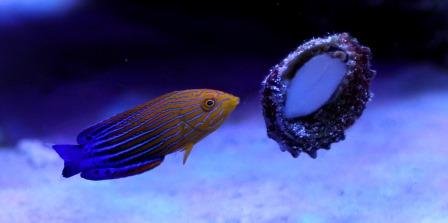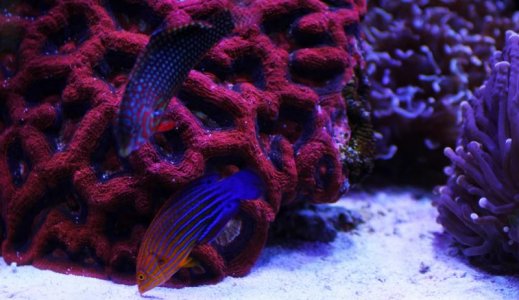WayneL333
New member
Hi everyone,
I thought I'd post my working theory on how to get a femininus wrasse to thrive in a reef tank. I've tried a few costly times before and I never got them to survive long term. I provided them with a deep sand bed (my display tank has a 6" sand bed), plenty of live rock with pods, and a reef tank environment. I would see them eat and pick on the live rock and sand, and thought they were doing well since they were 'eating' but they'd disappear after a couple of weeks. And this is why I think they did. They starved to death.
You can tell this is how they eat in the wild. You can see their conspicuous front sharp protruding teeth and when they feed in my reef tank, I can hear a clicking noise so you know they have a strong bite. They hunt and pick on all the rock and sand and in the wild, there's plenty of fauna to support them. However in a reef tank, unless your tank is packed with pods, which most tanks have barely enough pods to support mandarin gobies, the femininus eventually starve to death.
So the way I found success this time around is by first, ordering from LA DD. I'm a huge fan of theirs and think they're prices are worth every penny. Not only because of their acclimation and conditioning protocols, but mostly because of their 2 week guarantee. Second, I kept my femininus in it's own QT tank that I have plumbed into my established shallow reef/FOWLR system. My QT tank is 50g and has about a 3" sand bed with plenty of rocks inside of it.
I found that you have to train and condition the femininus to eat dried or frozen food, which they will do eventually. But it takes time. The problem is that when most people release them into an establish reef tank the femininus can't compete with the other tank inhabitants in eating the prepared foods during feeding time. Hence they never learn how to eat the prepared food and continue to forage for food which ultimately can't sustain them. When you keep them in their own tank, I found that after about 5-7 days, they learn to take your prepared foods. I start off by defrosting mysis shrimp and injecting them into the water column via a baster. The femininus will see the food in the water column and will eventually start to eat it. Then after a few days of doing that, I'll just drop chunks of the frozen food and the femininus will eventually see the food floating on top and will start to feed on that. Finally after that, I'll mix some pellets with the frozen food and the femininus will start eating pellets. Now you've got them trained to feed on pellets. After a month of seeing them eating well and getting plump, I'll then release it into my display reef tank. It takes them a few days, but they'll get used to your feeding regimen in the reef tank and can compete with your other established fish during feeing time.
Anyway, I'm 2 for 2 now. I have one femininus is my reef tank for about a month now and it has previously has made it through a month of QT. Here's a video of it eating in my display reef tank (you can even kind of hear the clicking sound that they make when biting on the cube of frozen food):
From the water column:
<embed width="600" height="361" type="application/x-shockwave-flash" allowFullscreen="true" allowNetworking="all" wmode="transparent" src="http://static.photobucket.com/player.swf" flashvars="file=http%3A%2F%2Fvid9.photobucket.com%2Falbums%2Fa89%2FWayneL333%2FMobile%2520Uploads%2Ftrim.2EC0FB90-6AC3-4D4A-81C1-295D7204EB8B_zpsz2qbxf4v.mp4&title=">
http://vid9.photobucket.com/albums/...0-6AC3-4D4A-81C1-295D7204EB8B_zpsz2qbxf4v.mp4
Holding its own with everyone else:
<embed width="600" height="361" type="application/x-shockwave-flash" allowFullscreen="true" allowNetworking="all" wmode="transparent" src="http://static.photobucket.com/player.swf" flashvars="file=http%3A%2F%2Fvid9.photobucket.com%2Falbums%2Fa89%2FWayneL333%2FMobile%2520Uploads%2Ftrim.CCD9B103-B553-4678-B5CC-C5BDBCD50337_zpsmjy7csbu.mp4&title=">
http://vid9.photobucket.com/albums/...3-B553-4678-B5CC-C5BDBCD50337_zpsmjy7csbu.mp4
<embed width="600" height="361" type="application/x-shockwave-flash" allowFullscreen="true" allowNetworking="all" wmode="transparent" src="http://static.photobucket.com/player.swf" flashvars="file=http%3A%2F%2Fvid9.photobucket.com%2Falbums%2Fa89%2FWayneL333%2FMobile%2520Uploads%2Ftrim.F7A71BAC-DD50-47CA-BF77-FB59BC80B868_zpsr2j2r1d4.mp4&title=">
http://vid9.photobucket.com/albums/...C-DD50-47CA-BF77-FB59BC80B868_zpsr2j2r1d4.mp4
As you can see, it eats voraciously with my other tank inhabitants. Even pellet foods too.
Here's my other femininus still in my QT tank:

I would have already moved to my reef tank but I actually just picked up these two bad boys yesterday!

I'm going to really put my theory to test. I put them into the same QT tank as I currently have the female in. I'm hoping the female will help condition and train these two new males. The female had already buried itself in the sand for the evening when I released them into the tank so I couldn't get a group shot but here are some pics of the males:


And the smaller of the two flashing it's body colors after seeing the larger male:


This is why I love the males so much. I love that they flash that mustard yellow body color. It's so cool!
Anyway, I thought I'd post my experiences. Please feel free to add your tips on how you got your femininus to live long term.
I thought I'd post my working theory on how to get a femininus wrasse to thrive in a reef tank. I've tried a few costly times before and I never got them to survive long term. I provided them with a deep sand bed (my display tank has a 6" sand bed), plenty of live rock with pods, and a reef tank environment. I would see them eat and pick on the live rock and sand, and thought they were doing well since they were 'eating' but they'd disappear after a couple of weeks. And this is why I think they did. They starved to death.
You can tell this is how they eat in the wild. You can see their conspicuous front sharp protruding teeth and when they feed in my reef tank, I can hear a clicking noise so you know they have a strong bite. They hunt and pick on all the rock and sand and in the wild, there's plenty of fauna to support them. However in a reef tank, unless your tank is packed with pods, which most tanks have barely enough pods to support mandarin gobies, the femininus eventually starve to death.
So the way I found success this time around is by first, ordering from LA DD. I'm a huge fan of theirs and think they're prices are worth every penny. Not only because of their acclimation and conditioning protocols, but mostly because of their 2 week guarantee. Second, I kept my femininus in it's own QT tank that I have plumbed into my established shallow reef/FOWLR system. My QT tank is 50g and has about a 3" sand bed with plenty of rocks inside of it.
I found that you have to train and condition the femininus to eat dried or frozen food, which they will do eventually. But it takes time. The problem is that when most people release them into an establish reef tank the femininus can't compete with the other tank inhabitants in eating the prepared foods during feeding time. Hence they never learn how to eat the prepared food and continue to forage for food which ultimately can't sustain them. When you keep them in their own tank, I found that after about 5-7 days, they learn to take your prepared foods. I start off by defrosting mysis shrimp and injecting them into the water column via a baster. The femininus will see the food in the water column and will eventually start to eat it. Then after a few days of doing that, I'll just drop chunks of the frozen food and the femininus will eventually see the food floating on top and will start to feed on that. Finally after that, I'll mix some pellets with the frozen food and the femininus will start eating pellets. Now you've got them trained to feed on pellets. After a month of seeing them eating well and getting plump, I'll then release it into my display reef tank. It takes them a few days, but they'll get used to your feeding regimen in the reef tank and can compete with your other established fish during feeing time.
Anyway, I'm 2 for 2 now. I have one femininus is my reef tank for about a month now and it has previously has made it through a month of QT. Here's a video of it eating in my display reef tank (you can even kind of hear the clicking sound that they make when biting on the cube of frozen food):
From the water column:
<embed width="600" height="361" type="application/x-shockwave-flash" allowFullscreen="true" allowNetworking="all" wmode="transparent" src="http://static.photobucket.com/player.swf" flashvars="file=http%3A%2F%2Fvid9.photobucket.com%2Falbums%2Fa89%2FWayneL333%2FMobile%2520Uploads%2Ftrim.2EC0FB90-6AC3-4D4A-81C1-295D7204EB8B_zpsz2qbxf4v.mp4&title=">
http://vid9.photobucket.com/albums/...0-6AC3-4D4A-81C1-295D7204EB8B_zpsz2qbxf4v.mp4
Holding its own with everyone else:
<embed width="600" height="361" type="application/x-shockwave-flash" allowFullscreen="true" allowNetworking="all" wmode="transparent" src="http://static.photobucket.com/player.swf" flashvars="file=http%3A%2F%2Fvid9.photobucket.com%2Falbums%2Fa89%2FWayneL333%2FMobile%2520Uploads%2Ftrim.CCD9B103-B553-4678-B5CC-C5BDBCD50337_zpsmjy7csbu.mp4&title=">
http://vid9.photobucket.com/albums/...3-B553-4678-B5CC-C5BDBCD50337_zpsmjy7csbu.mp4
<embed width="600" height="361" type="application/x-shockwave-flash" allowFullscreen="true" allowNetworking="all" wmode="transparent" src="http://static.photobucket.com/player.swf" flashvars="file=http%3A%2F%2Fvid9.photobucket.com%2Falbums%2Fa89%2FWayneL333%2FMobile%2520Uploads%2Ftrim.F7A71BAC-DD50-47CA-BF77-FB59BC80B868_zpsr2j2r1d4.mp4&title=">
http://vid9.photobucket.com/albums/...C-DD50-47CA-BF77-FB59BC80B868_zpsr2j2r1d4.mp4
As you can see, it eats voraciously with my other tank inhabitants. Even pellet foods too.
Here's my other femininus still in my QT tank:

I would have already moved to my reef tank but I actually just picked up these two bad boys yesterday!

I'm going to really put my theory to test. I put them into the same QT tank as I currently have the female in. I'm hoping the female will help condition and train these two new males. The female had already buried itself in the sand for the evening when I released them into the tank so I couldn't get a group shot but here are some pics of the males:


And the smaller of the two flashing it's body colors after seeing the larger male:


This is why I love the males so much. I love that they flash that mustard yellow body color. It's so cool!
Anyway, I thought I'd post my experiences. Please feel free to add your tips on how you got your femininus to live long term.
Last edited:













